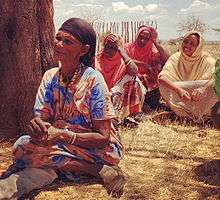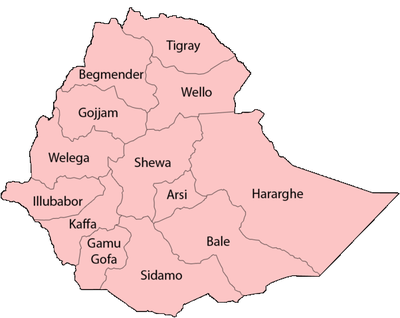Borana Oromo people
 Borana women | |
| Regions with significant populations | |
|---|---|
| Ethiopia, Kenya | |
| Languages | |
| Borana[1] | |
| Religion | |
| Traditional Religion (Waaq), Islam, Christianity | |
| Related ethnic groups | |
| Oromo · Barentu · Gabbra and other Cushitic peoples. |
The Borana Oromo people, also called the Boran, are a sub-ethnic section of the Oromo people, who live in southern Ethiopia (Oromia) and northern Kenya.[1][2] They speak a dialect of the Oromo language, that is distinct enough that it is difficult for other Oromo speakers to understand.[2] The Borana people are notable for their historic Gadda political system. They follow their traditional religions, Ethiopian Orthodox Christianity,[3] Islam[4] or Protestant Christianity.[5][6]
Demography and language

Between the twelfth and fifteenth centuries, the Oromo people had differentiated into two major confederation of pastoral tribes: the Borana and the Barentu, and several minor ones. The Barentu people thereafter expanded to the eastern regions now called Hararghe, Arsi, Wello and northeastern Shawa. The Borana people, empowered by their Gadda political and military organization expanded in the other directions, regions now called western Shawa, Welega, Illubabor, Kaffa, Gamu Goffa, Sidamo and thereafter into what is now northern Kenya regions. The Borana further subdivided into various subgroups such as Macha, Tulama, Sadacha and others.[7]
The Borana speak Borana (or afaan Booranaa), a dialect of Oromo language, which is part of the Cushitic branch of the Afro-Asiatic family of languages. In the border regions of Ethiopia-Kenya and southwestern Somalia, one estimate places about 220,000 people as Boranas.[8] Another estimate in 2011, suggests 177,000 Boranas in Ethiopia and 95,000 in Kenya.[2]
History
The Borana, Gabbra and Sakuye peoples are sub-ethnic groups within the Oromo people group, and share language and culture. Some groups from the Oromo people from southern Ethiopia entered northern Kenya fduring the 16th century. These Borana groups then differentiated into the cattle-keeping, while the Gabbra and Sakuye specialized in camel-keeping. They lived together, each with different pastoral focus. As competition for grazing lands and resources increased, conflicts emerged.[9]
Society
Gadda
The Oromo people were traditionally a culturally homogeneous society with genealogical ties.[10] The Borana[2] and other Oromo communities governed themselves in accordance with Gadaa (literally "era"), a limited democratic socio-political system long before the 16th century, when major three party wars commenced between them and the Christian kingdom to their north and Islamic sultanates to their east and south. The Gadda system elected males from five Oromo miseensa (groups), for a period of eight years, for various judicial, political, ritual and religious roles. Retirement was compulsory after the eight year term, and each major clan followed the same Gadaa system.[10] Women and people belonging to the lower Oromo castes were excluded.[11] Male born in the upper Oromo society went through five stages of eight years, where his life established his role and status for consideration to a Gadaa office.[10]
Under Gadaa, every eight years, the Oromo would choose by consensus an Abbaa Bokkuu responsible for justice, peace, judicial and ritual processes, an Abbaa Duulaa responsible as the war leader, an Abbaa Sa'aa responsible as the leader for cows, and other positions.[12]
Social stratification
Like other ethnic groups in the Horn of Africa and East Africa, Borana Oromo people regionally developed social stratification consisting of four hierarchical strata. The highest strata were the nobles called the Borana, below them were the Gabbaro (some 17th to 19th century Ethiopian texts refer them as the dhalatta). Below these two upper castes were the despised castes of artisans, and at the lowest level were the slaves.[13][14]
See also
Notes
- 1 2 Oromo, Borana-Arsi-Guji (Ethnologue)
- 1 2 3 4 Steven L. Danver (2015). Native Peoples of the World: An Encylopedia of Groups, Cultures and Contemporary Issues. Routledge. pp. 24–25. ISBN 978-1-317-46400-6.
- ↑ Cornelius J. Jaenen (1956), The Galla or Oromo of East Africa, Southwestern Journal of Anthropology, Vol. 12, No. 2 (Summer, 1956), pages 171-190
- ↑ Aguilar, Mario (1996). "The Eagle as Messenger, Pilgrim and Voice: Divinatory Processes among the Waso Boorana of Kenya". Journal of Religion in Africa. pp. 56–72. Retrieved 2007-10-27.
- ↑ Tollossa, Worku; Edessa, Negera; Ajebu, Nurfeta; Haile, Welearegay (2014). "Milk handling practices and its challenges in Borana Pastoral Community, Ethiopia". African Journal of Agricultural Research. Academic Journals. 9 (15): 1192–1199. doi:10.5897/ajar2013.8247.
- ↑ Karbo, Tony (2013). "Religion and social cohesion in Ethiopia". International Journal of Peace and Development Studies. Academic Journals. 4 (3): 43–52. doi:10.5897/ijpds2013.0164.
- ↑ Asafa Jalata (2010), Oromo Peoplehood: Historical and Cultural Overview, Sociology, University of Tennessee Press, pages 5, 11-12
- ↑ Appiah & Gates 2010, p. 196.
- ↑ Elliot Fratkin; Eric Abella Roth (2006). As Pastoralists Settle: Social, Health, and Economic Consequences of the Pastoral Sedentarization in Marsabit District, Kenya. Springer. pp. 38–39. ISBN 978-0-306-48595-4.
- 1 2 3 Tesema Ta'a (2006). The Political Economy of an African Society in Tranformation: the Case of Macca Oromo (Ethiopia). Otto Harrassowitz Verlag. pp. 24–25. ISBN 978-3-447-05419-5.
- ↑ Paul Trevor William Baxter; Jan Hultin; Alessandro Triulzi (1996). Being and Becoming Oromo: Historical and Anthropological Enquiries. Nordic Africa Institute. pp. 252–253. ISBN 978-91-7106-379-3., Quote: "gadaa government was a preclass institution based on democratic principles even though it did exclude caste groups such as smiths and tanners, and women (...)".
- ↑ Tesema Ta'a (2006). The Political Economy of an African Society in Tranformation: the Case of Macca Oromo (Ethiopia). Otto Harrassowitz Verlag. pp. 26–27. ISBN 978-3-447-05419-5.
- ↑ J. Abbink (1985), Review: Oromo Religion. Myths and Rites of the Western Oromo of Ethiopia by Lambert Bartels, Journal: Anthropos, Bd. 80, H. 1./3. (1985), pages 285-287
- ↑ Paul Trevor William Baxter; Jan Hultin; Alessandro Triulzi (1996). Being and Becoming Oromo: Historical and Anthropological Enquiries. Nordic Africa Institute. pp. 254–256. ISBN 978-91-7106-379-3.
References
| Wikinews has related news: Children massacred in Kenyan school |
- Appiah, Kwame Anthony; Gates, Henry Louis, Jr., eds. (2010), Encyclopedia of Africa, Oxford University Press, ISBN 978-0-19-533770-9
Further reading
- Asmarom Legesse. Gada Three Approaches to the Study of African Society. The Free Press A Division of McMillan Co. Inc, 1973
- Beckingham and G.W.B. Huntingford, Some records of Ethiopia Hakluyt Society, 1954
- Bassi Marco, Decisions in the Shade. Political and juridical processes among the Oromo-Borana Red Sea Press, 2005
- Clifford H F Plowman CMG OBE, Notes On The Gedamoch Ceremonies Among The Boran, (Journal of the Royal African Society, Vol. 18, No. 70 (Jan., 1919), pp. 114-121 )